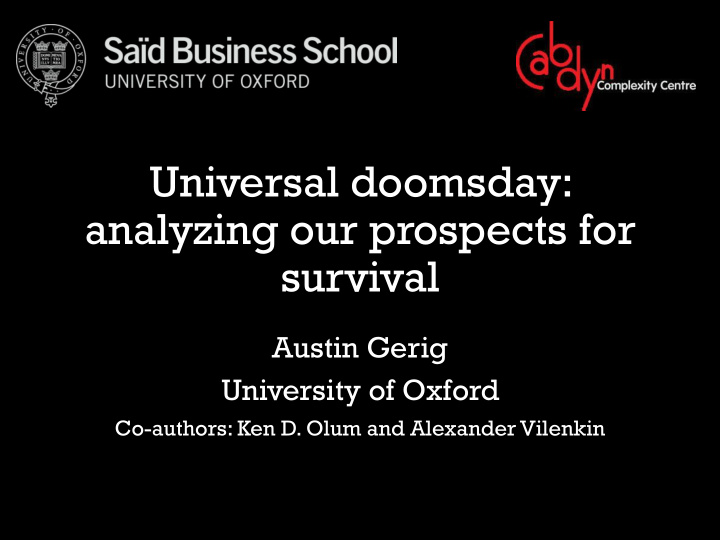



Universal doomsday: analyzing our prospects for survival Austin Gerig University of Oxford Co-authors: Ken D. Olum and Alexander Vilenkin
“There is something fascinating about science. One gets such wholesome returns of conjectures out of such trifling investment of fact.” -Mark Twain
Can we answer questions about the universe and about our place in the universe using only a “trifling investment” of fact?
Consider the following facts, • Fact 1: • You and I exist. • Fact 2: • Our birth number within our civilization is around 70 billion.
From these facts, the following conjectures are likely, • Conjecture 1: • Many other civilizations exist. • Conjecture 2: • Most civilizations will not be large, i.e., most die out before producing quadrillions of people.
We can dismiss alternative hypotheses because they make one or both of our pieces of data surprising and unlikely. • If there are no other civilizations, our existence is unlikely. • If large civilizations are typical, we should have a much higher birth number.
Suppose an unspecified number of legos are chosen from the stadium and stacked into towers of two different sizes: Small: 10 bricks Large: 10 million bricks Small Large Tower Tower* * not to scale 19cm vs. 190km (~4m 3 )
or You are told that: (1) the yellow brick is in a tower. (2) it is located at position 7.
You are asked to guess how many towers there are and also the fraction of towers that are large, f L
Conjecture 1: one small tower Conjecture 2: one large tower Conjecture 3: many towers, most are large Conjecture 4: many towers, most are small Which conjecture is most likely?
Conjecture 1: one small tower
Conjecture 2: one large tower
Conjecture 3: many towers, most are large
Conjecture 4: many towers, most are small
Conjecture 4 is the only conjecture that produces our data as a typical result.
Calculations • Gerig (2012), arxiv:1209.625, considers all conjectures. • Here, I will follow Gerig, Olum, and Vilenkin (2013), JCAP , it is assumed that many towers (civilizations) exist so that only conjectures 3 and 4 are considered.
Likelihood
Posterior The probability that f L > 1/2 is 5% .
Starting from a uniform prior for f L , and after considering our datum, D , we find that in expectation 7% of towers are large.
Comparison to traditional doomsday Results of traditional doomsday argument are recovered when using prior that places ½ weight on f L = 0 and ½ weight on f L = 1.
Thank you!
Recommend
More recommend